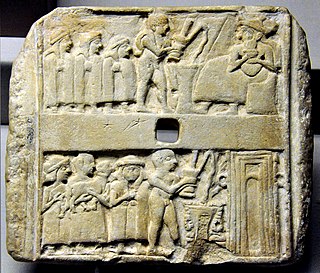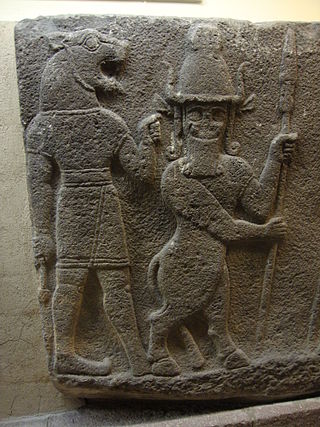
Enlil, later known as Elil, is an ancient Mesopotamian god associated with wind, air, earth, and storms. He is first attested as the chief deity of the Sumerian pantheon, but he was later worshipped by the Akkadians, Babylonians, Assyrians, and Hurrians. Enlil's primary center of worship was the Ekur temple in the city of Nippur, which was believed to have been built by Enlil himself and was regarded as the "mooring-rope" of heaven and earth. He is also sometimes referred to in Sumerian texts as Nunamnir. According to one Sumerian hymn, Enlil himself was so holy that not even the other gods could look upon him. Enlil rose to prominence during the twenty-fourth century BC with the rise of Nippur. His cult fell into decline after Nippur was sacked by the Elamites in 1230 BC and he was eventually supplanted as the chief god of the Mesopotamian pantheon by the Babylonian national god Marduk.

Ninḫursaĝ sometimes transcribed Ninursag, Ninḫarsag, or Ninḫursaĝa, also known as Damgalnuna or Ninmah, was the ancient Sumerian mother goddess of the mountains, and one of the seven great deities of Sumer. She is known earliest as a nurturing or fertility goddess. Temple hymn sources identify her as the "true and great lady of heaven" and kings of Lagash were "nourished by Ninhursag's milk". She is the tutelary deity to several Sumerian leaders.

In Sumerian and ancient Mesopotamian religion, gallûs were great demons or devils of the ancient Mesopotamian Underworld.

Ninurta (Sumerian: 𒀭𒊩𒌆𒅁: DNIN.URTA, possible meaning "Lord [of] Barley"), also known as Ninĝirsu (Sumerian: 𒀭𒎏𒄈𒋢: DNIN.ĜIR2.SU, meaning "Lord [of] Girsu"), is an ancient Mesopotamian god associated with farming, healing, hunting, law, scribes, and war who was first worshipped in early Sumer. In the earliest records, he is a god of agriculture and healing, who cures humans of sicknesses and releases them from the power of demons. In later times, as Mesopotamia grew more militarized, he became a warrior deity, though he retained many of his earlier agricultural attributes. He was regarded as the son of the chief god Enlil and his main cult center in Sumer was the Eshumesha temple in Nippur. Ninĝirsu was honored by King Gudea of Lagash (ruled 2144–2124 BC), who rebuilt Ninĝirsu's temple in Lagash. Later, Ninurta became beloved by the Assyrians as a formidable warrior. The Assyrian king Ashurnasirpal II (ruled 883–859 BC) built a massive temple for him at Kalhu, which became his most important cult center from then on.

In the Sumerian mythological poem Lugal-e, Asag or Azag, is a monstrous demon, so hideous that his presence alone makes fish boil alive in the rivers.

Anzû, also known as dZû and Imdugud, is a monster in several Mesopotamian religions. He was conceived by the pure waters of the Apsu and the wide Earth, or as son of Siris. Anzû was depicted as a massive bird who can breathe fire and water, although Anzû is alternately depicted as a lion-headed eagle.
Ancient Semitic religion encompasses the polytheistic religions of the Semitic peoples from the ancient Near East and Northeast Africa. Since the term Semitic itself represents a rough category when referring to cultures, as opposed to languages, the definitive bounds of the term "ancient Semitic religion" are only approximate.

Ashur, Ashshur, also spelled Ašur, Aššur is the national god of the ancient Assyrians.

Sumerian religion was the religion practiced by the people of Sumer, the first literate civilization of ancient Mesopotamia. The Sumerians regarded their divinities as responsible for all matters pertaining to the natural and social orders.
The Magilum Boat in Sumerian religion also known as the 'boat of the west' was one of the valuable items seized by Ninurta, patron god of Lagash, in ancient Iraq. This spoil was hung on an unknown part of his chariot according to the ancient source.It is also mentioned in The Epic of Gilgamesh: "All living creatures born of the flesh shall sit at last in the boat of the West, and when it sinks, when the boat of Magilum sinks, they are gone."
The Strong Copper in Sumerian religion was one of the valuable items seized by Ninurta, patron god of Lagash, in ancient Iraq. This spoil was hung "on the inside pole pin" of his chariot according to the ancient source.
The Dragon was one of the warriors slain by Ninurta, patron god of Lagash, in Sumerian religion. Its body was hung on the seat of his chariot according to the ancient source.
Lord Saman-Ana in Sumerian religion was one of the Heroes slain by Ninurta, patron god of Lagash, in ancient Iraq. Almost nothing else is mentioned of this "hero", his appearance is lacking.
The Bison-beast in Sumerian religion was one of the Heroes slain by Ninurta, patron god of Lagash, in Mesopotamia.
The Seven-headed Serpent in Sumerian religion was one of the Heroes slain by Ninurta, patron god of Lagash, in ancient Iraq. Its body was hung on the "shining cross-beam" of Ninurta's chariot.
The Six-headed Wild Ram in Sumerian religion was one of the Heroes slain by Ninurta, patron god of Lagash, in ancient Iraq. Its body was hung on the dust-guard of Ninurta's chariot.
Ur-Ninurta, c. 1859 – 1832 BC or c. 1923 – 1896 BC, was the 6th king of the 1st Dynasty of Isin. A usurper, Ur-Ninurta seized the throne on the fall of Lipit-Ištar and held it until his violent death some 28 years later.

Sharur, which means "smasher of thousands" is the weapon and symbol of the god Ninurta. Sumerian mythic sources describe it as an enchanted talking mace. It has been suggested as a possible precursor for similar objects in other mythology such as Arthurian lore.

Kusarikku ("Bull-Man") was an ancient Mesopotamian mythological demon shown in artistic representation from the earliest times with the arms, torso and head of a human and the ears, horns and hindquarters of a bull. He is portrayed as walking upright and characterized as a door keeper to protect the inhabitants from malevolent intruders. He is one of the demons which represented mountains. He is pictured in late iconography holding a banduddû, "bucket". On a stela of Meli-Šipak, the land grant to Ḫasardu kudurru, he is pictured carrying a spade.

The work known by its incipit, Angim, "The Return of Ninurta to Nippur", is a rather obsequious 210-line mythological praise poem for the ancient Mesopotamian warrior-god Ninurta, describing his return to Nippur from an expedition to the mountains (KUR), where he boasts of his triumphs against "rebel lands" (KI.BAL), boasting to Enlil in the Ekur, before returning to the Ešumeša temple—to “manifest his authority and kingship.”